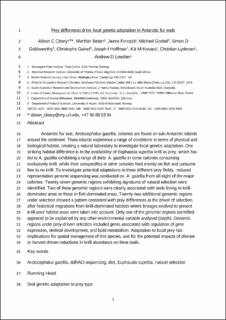| dc.contributor.author | Cleary, Alison Clare | |
| dc.contributor.author | Bester, Marthán N. | |
| dc.contributor.author | Forcada, Jaume | |
| dc.contributor.author | Goebel, Michael | |
| dc.contributor.author | Goldsworthy, Simon D. | |
| dc.contributor.author | Guinet, Christophe | |
| dc.contributor.author | Hoffman, Joseph I. | |
| dc.contributor.author | Kovacs, Kit M. | |
| dc.contributor.author | Lydersen, Christian | |
| dc.contributor.author | Lowther, Andrew | |
| dc.date.accessioned | 2020-03-25T00:01:01Z | |
| dc.date.available | 2020-03-25T00:01:01Z | |
| dc.date.created | 2019-10-30T12:34:57Z | |
| dc.date.issued | 2019 | |
| dc.identifier.citation | Cleary, A. C., Bester, M. N., Forcada, J., Goebel, M., Goldsworthy, S. D., Guinet, C., . . . Lowther, A. (2019). Prey differences drive local genetic adaptation in Antarctic fur seals. Marine Ecology Progress Series, 628, 195-209. doi: | en_US |
| dc.identifier.issn | 1616-1599 | |
| dc.identifier.uri | https://hdl.handle.net/11250/2648453 | |
| dc.description | Author's accepted version (postprint). | en_US |
| dc.description | Available from 11/10/2020. | |
| dc.description.abstract | Antarctic fur seal (Arctocephalus gazella) colonies are found on sub-Antarctic islands around the continent. These islands experience a range of conditions in terms of physical and biological habitat, creating a natural laboratory to investigate local genetic adaptation. One striking habitat difference is in the availability of Euphausia superba krill as prey, which has led to A. gazella exhibiting a range of diets. A. gazella in some colonies consume exclusively krill, while their conspecifics in other colonies feed mainly on fish and consume few to no krill. To investigate potential adaptations to these different prey fields, reduced representation genome sequencing was conducted on A. gazella from the 8 major colonies. Twenty-seven genomic regions exhibiting signatures of natural selection were identified. Two of these genomic regions were clearly associated with seals living in krill-dominated areas or those in fish-dominated areas. Twenty-two additional genomic regions under selection showed a pattern consistent with prey differences as the driver of selection after historical migrations from krill-dominated habitats where lineages evolved to present krill-poor habitat areas were taken into account. Only 1 of the genomic regions identified appeared to be explained by any other environmental variable analysed (depth). Genomic regions under prey-driven selection included genes associated with regulation of gene expression, skeletal development, and lipid metabolism. Adaptation to local prey has implications for spatial management of this species and for the potential impacts of climate- or harvest-driven reductions in krill abundance on these seals. | en_US |
| dc.language.iso | eng | en_US |
| dc.publisher | Inter Research | en_US |
| dc.title | Prey differences drive local genetic adaptation in Antarctic fur seals | en_US |
| dc.type | Journal article | en_US |
| dc.type | Peer reviewed | en_US |
| dc.description.version | acceptedVersion | en_US |
| dc.subject.nsi | VDP::Matematikk og Naturvitenskap: 400::Zoologiske og botaniske fag: 480::Marinbiologi: 497 | en_US |
| dc.source.pagenumber | 195-209 | en_US |
| dc.source.volume | 628 | en_US |
| dc.source.journal | Marine Ecology Progress Series | en_US |
| dc.identifier.doi | 10.3354/meps13108 | |
| dc.identifier.cristin | 1742223 | |
| dc.relation.project | Notur/NorStore: NN9515K | en_US |
| cristin.qualitycode | 2 | |
